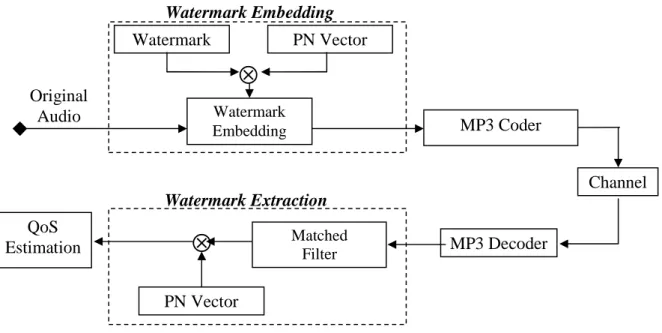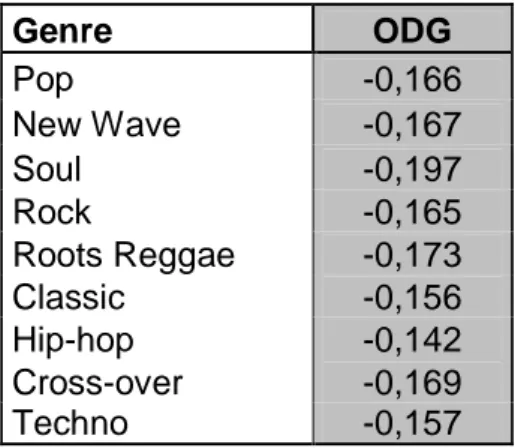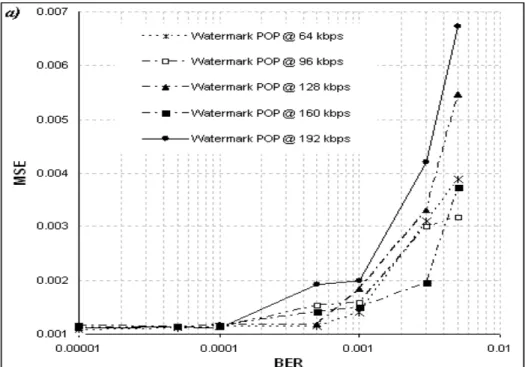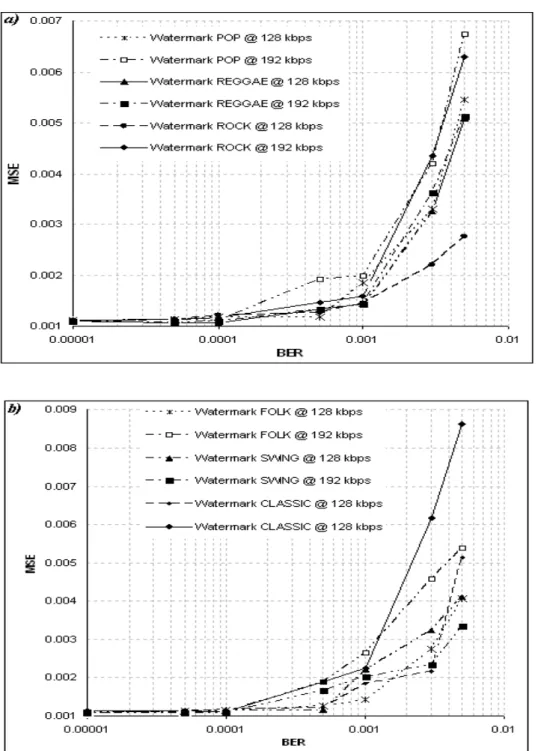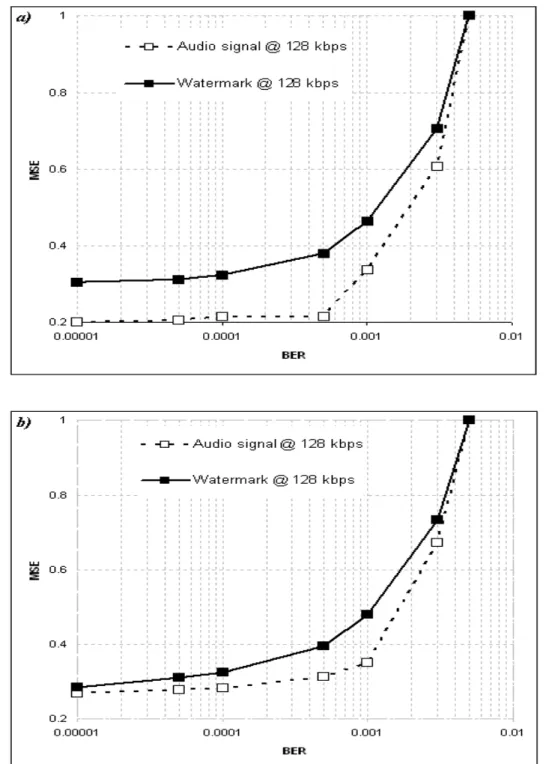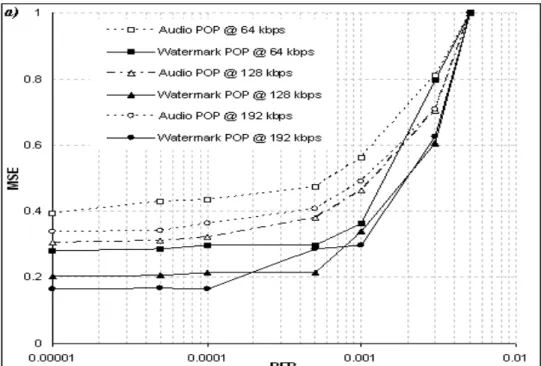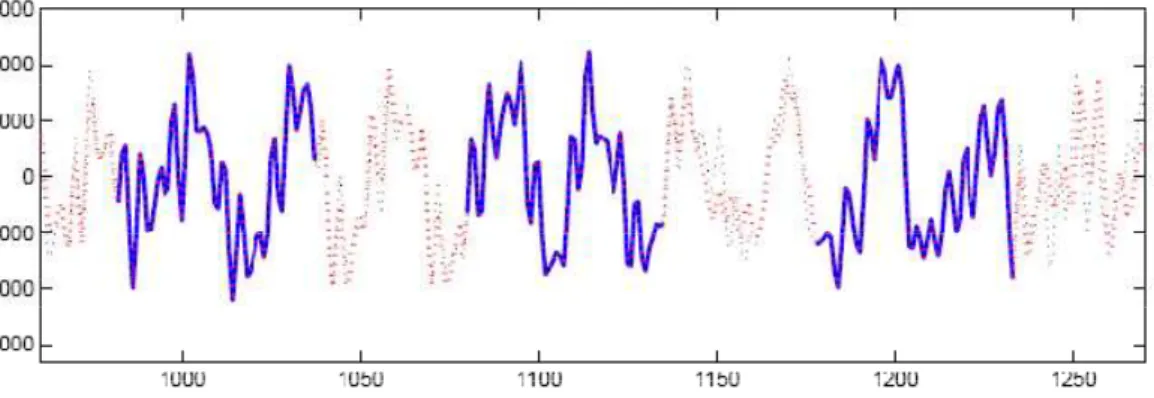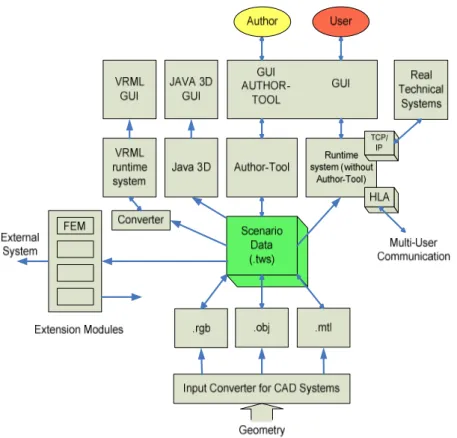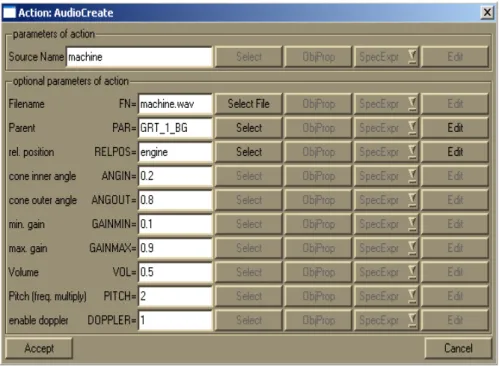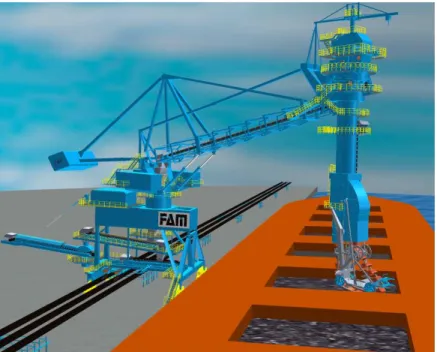Università di Roma3
Rome, Italy
Audio Digital Signal
Processing: techniques
and applications
Carlo Belardinelli
A dissertation submitted in partial satisfaction
of the requirements for the degree of
Doctor of Philosophy
in
Engineering
in the
Applied Electronics Division
of the
UNIVERSITY OF ROMA3, ROME; ITALY
Copyright © 2009
by Carlo Belardinelli
Author’s Address
Carlo Belardinelli
Viale Marco Polo 84, 00154, Roma, Italy
Galvanistraat 126, 2517RE, The Hague, The Netherlands
EMAIL: [email protected]
Table of contents
I.
Abstract in Italiano
II.
Introduction
III.
Audio Digital Watermarking
1. Motivation
2. Idea: Fragile watermarking for QoS assessment
3. Implementation
4. QoS measurements used
5. Results
6. Conclusions
IV.
Audio Restoration
1.
Motivation
2.
Theoretical Fundamentals: Bayesian approach and
Phase Vocoder
3.
Implementation
4. Missing samples calculation: Kalman filter and
smoothing
5. Results
6. Conclusions
V.
Audio in VR: 3D Sound in virtual
scenarios
1.
Motivations
3.
Developments, Examples, and Results
4.
Conclusions
VI.
Audio in VR: The Digital Factory,
the new outpost of virtual design
1.
Motivations
2.
The noise problem and the noise control plug-in
rationale
3.
Implementation: techniques and workflow
4.
Results
5.
Conclusion and future developments
VII.
Conclusions
VIII.
Annex A
IX.
Annex B
I
Abstract in Italiano
In questa tesi viene descritta la mia attività di ricerca svolta durante il corso di dottorato in Elaborazione Elettronica del Segnale Audio. Durante questi tre anni ho sviluppato il quadro di riferimento teorico in questo ambito realizzando poi diverse applicazioni pratiche che vengono riportate in dettaglio nei capitoli seguenti dopo un’introduzione generale (Capitolo II). In particolare sono stati sviluppati i concetti seguenti:
• Nel terzo capitolo viene presentato un sistema di marchiatura digitale audio che permette la valutazione della qualità di una trasmissione in sistemi di comunicazione di terza generazione senza influire sul payload dei contenuti inviati né tantomeno peggiorare la qualità dei contenuti musicali trasmessi, sviluppato durante il primo anno di corso presso il dipartimento di Elettronica Applicata dell’Università di RomaTre. I risultati raggiunti confermano l’efficacia del sistema e ne permettono l’applicazione in sistemi di comunicazione radio mobile di terza generazione (UMTS) e internet WIFI (IEEE 802.11).
In particolare un watermark fragile viene inserito tramite tecniche spread-spectrum nel dominio DCT all’interno della regione delle frequenze medio-alte dei frame del segnale musicale. Il principio base dell'idea consiste nell'ipotesi che, poiché marchio e segnale audio marchiato sono entrambi sottoposti alle stesse operazioni di codifica/decodifica e viaggiano sullo stesso canale di trasmissione, il livello di degradazione del watermark dopo la ricezione è supposto essere proporzionale al livello di deteriorazione subita dal segnale audio stesso. In ricezione è infatti a disposizione la versione originale del marchio (avente un payload trascurabile): una volta estratti i watermark ricevuti dai frame del segnale audio, questi vengono mediati di modo da ottenere un'unica versione del marchio ricostruito che puo' essere utilizzato come riferimento per il calcolo del QoS (Quality of Service) della trasmissione.
Infatti, mentre l'uso del PEAQ (Perceptual Evaluation of Audio Quality, standard ITU BS-1387) è stato utilizzato per provare l'effettiva completa trasparenza del marchio all'udito umano, i risultati delle sperimentazioni testimoniano la sensibilità del sistema di marchiatura fragile proposto nell'ottenere una stima blind della bontà della
comunicazione: l'errore quadratico medio del marchio (MSE), difatti, non solo si rivela essere proporzionale al numero di errori introdotti dal canale, ma é strettamente proporzionale all'errore quadratico medio del segnale audio rivevuto in cui é stato inserito.
• Nel periodo da visiting student presso il Signal Processing Lab della University of Cambridge (UK), ho implementato e verificato le prestazioni di un Phase Vocoder Probabilistico applicato alla ricostruzione dei campioni andati perduti all’interno di un file musicale. Nel quarto capitolo viene illustrato come questa applicazione abbia prestazioni incoraggianti per quel che riguarda la stima di informazioni musicali a contenuto informativo residuo nullo tramite strumenti di calcolo probabilistico bayesiano.
Dopo aver utilizzato il Phase Vocoder come modello generativo del segnale audio, viene definita la versione stocastica dello spazio di stato. Il Phase Vocoder Probabilistico permette l'applicazione di un filtraggio di Kalman e di uno smoothing secondo le equazioni di Rauch-Tung-Striebel. L'algoritmo di Expectation Maximization permette la derivazione di una procedura ricorsiva che permette infine di stimare iterativamente tramite maximum likelihood i parametri del suddetto spazio di stato che meglio approssimano i campioni mancanti.
• Infine presso il Fraunhofer Institut di Magdeburg in Germania ho sviluppato delle ricerche sul tema “Interaction of Sound in Virtual Reality”. In questo contesto:
o Ho sviluppato e testato la funzione audio della piattaforma grafica per realtà virtuale, elaborata dal Virtual Development and Training Centre in seno all’Istituto stesso, che permette in maniera agile di ottenere suoni 3D all’interno di scenari virtuali (capitolo V).
La core function è implementata utilizzando l'API OpenAL in maniera da rendere la realizzazione di contesti sonori virtuali, che si integrano con la rispettiva rappresentazione visiva, intuitiva ma al tempo stesso completa per la creazione e diffusione tridimensionale del segnale acustico. Per quanto riguarda il punto di vista del fruitore degli scenari virtuali, la spazializzazione del suono è implementata in maniera efficace di modo tale che l'elaborazione sonora avviene in real-time, anche con hardware non dedicato. L’Audio Core Function permette usi innovativi del suono in rappresentazioni 3D, testati tramite diversi scenari virtuali qui di seguito riportati.
o Ho ideato e implementato il workflow per un plugin che permetta di visualizzare nello spazio virtuale (in particolare all’interno della Digital Factory) il campo acustico, simulato in maniera fedele da efficienti strumenti di CAE appositi, generato da macchinari industriali (capitolo VI).
Il livello di pressione sonora (SPL) viene calcolato in maniera fedele tramite accurate simulazioni ed elaborati strumenti di calcolo ricorrendo al Boundary e Finite Element Methods. I valori di SPL ottenuti al termine dell'analisi acustica possono venire importati facilmente dalla piattaforma di Realtà Virtuale, poiché vengono salvati in formato altamente editabile. In questo modo é possibilie verificare in 3 dimensioni la conformità di progetti di nuovi siti industriali alle norme sulle soglie di rumore in ambienti lavorativi e apportare eventuali
correzioni (applicando anche tecniche di Active Noise Control, ANC), prima che la fabbrica sia concretamente realizzata.
L’attività di ricerca da me svolta durante il dottorato è stata oggetto di presentazioni in conferenze internazionali (quali la IEEE European Signal Processing Conference 2006 a Firenze o l’IEEE Workshop on Application of Signal Processing on Audio and Acoustics 2007 a New Paltz, New York) e ha mostrato l’efficacia delle tecniche di DSP per quanto riguarda il segnale audio.
Nella società odierna in cui si sovraccaricano i sensi -e quindi anche e soprattutto l’udito- di contenuti informativi, una migliore gestione del contenuto dell’informazione sonora può dunque essere una chiave per un progresso che aiuti effettivamente a vivere meglio.
II
Introduction
This thesis about Digital Signal Processing (DSP) applied to the audio signal is the outcome of three years of researches I carried out and a keen interest for music and audio in general.
Scientific investigations and passion for music have mixed together in my PhD topic. This implies the acquisition of the analog (as everything created by Mother Nature) audio content, its digitalization and its subsequent modification and processing by means of a computers in order to achieve the most various aims. During the first decades of computer development (i.e. until the end of the Seventies) this research field, if compared to the field of Digital Signal Processing in general (for example applied to the images), has not seen a wide evolution and diffusion. Although analog processing allowed yet covering fundamental needs (think about telephones invented in the nineteenth century), audio digital signal processing had not wide applications (also because of the particular intrinsic complexity of the audio signal which made inadequate the computational resources available at that time).
In the early Eighties the Compact Disc invention and diffusion, introducing to the large markets the digital music concept, and most notably the introduction of audio processing dedicated chips (with a simple and limited instruction set but tailored to the operation to be performed on the sound signal, as in the prominent case of the Motorola 56001), changed this situation. Audio DSP stopped being an exclusive field for specialized laboratories and centers of excellence and became instead a rather hot topic for researchers and developers across the world. This scenario has lead to a technological boom during the Nineties, providing the consumers with innovations as the MP3(©) format or the 5.1 home audio, while new affordable commercial sound cards have started allowing everyone owning a consumer computer to put to the test the newly discovered software audio manipulation findings.
Audio DSP is thus a relatively young but dynamic research area in which applications and new developments are continuously defined and worked out. These incremental research dynamics are reflected in this thesis together with two other life aspects which technology innovations (along with human progress) made easier, which are relocating and co-working. In
fact, the aforementioned interest for this scientific field has brought me to carry out the researches I am about to disclose in three different areas of conceivable application of the DSP techniques to audio, within three different laboratories, in three different countries in Europe. Therefore, in the frame of a clear common point, i.e. the need of modifying some audio content, in the form of a sound wave, my thesis is focused on four particular applications spanning the three aforementioned fields in order to get some particularly useful aims.
During the first period of my PhD studies I researched in my hometown, Rome, working at the Digital Signal Processing, Multimedia, and Optical Communications Lab at the University of Roma3 under the direct supervision of Professor Gaetano Giunta. Here, I focused on the field of digital audio watermarking, and in particular the processing of the audio signal in such a way, that the quality of a transmission of this very signal could be assessed without the need of investigating the physical limitations and influences of the transmission channel.
I was then visiting student at the University of Cambridge (UK). Here I had the opportunity to join the Signal Processing and Communications Lab directed by Professor William Fitzgerald. I got there an amazing insight about the statistical Bayesian approach for audio DSP. In particular I worked to the implementation of a system for the restoration of corrupted samples within a musical signal envelope.
Finally, I became Marie Curie Fellow and worked at the Fraunhofer IFF, in Magdeburg, Germany, directed by Professor Michael Schenk. Supported also by the Otto-von-Guericke University (supervisor Professor Ulrich Gabbert), I investigated the various applications of the audio signal processing within the Virtual Reality. Firstly I implemented the necessary functions to modify the sound signal and its reproduction so that, becoming three-dimensional it could sound the most real possible. Later on, I focused my research work on the numerical calculation and visual representation of sound fields within virtual factories, developing an application devoted to the noise reduction and control, another rising topic in Audio DSP.
Acknowledgements
All the above mentioned scientific and human experiences were made possible by the helpfulness of several people.
First of all I wish to thank my supervisor and tutor, Professor Gaetano Giunta for his constant scientific support through those three years. Not only he has been constantly available and full of precious teachings (very often even remotely!) but he shared his international working links fostering my international research career. I am very grateful to him.
To the doctoral Teaching Board at the Department of Applied Electronics of the University of Roma3, I am obliged for the availability shown as regards my needs as a post graduate student abroad, allowing me to pursue my scientific aims in different places with their valuable practical and academic support: without their open minds I would not be here writing this thesis.
Thanks to the grant delivered by the International Liaisons Office of Roma3, I was able to spend a research period in Cambridge: to Professor William Fitzgerald, for introducing me in his Lab with full enthusiasm and Dr. Taylan Cemgil for driving me with involvement and patience through a scientific field as interesting as completely new to me, my thankful thoughts.
Finally, I would like to show my appreciation and commitment to all People I have worked with in Germany. In particular to Doctor Eberhard Blümel, for giving me the possibility to join the Fraunhofer Community: the trust he showed allowing me to follow my research pursue while
still providing me with useful insights and practical hints related to the world of the industry were of the greatest importance. His determination and enthusiasm concerning new ideas arisen during our talks, together with his solid scientific background will always be a reference point to me. A special thank goes to Professor Ulrich Schmucker who, as a manager and supervisor along my fellowship at the Fraunhofer, introduced me into the world and technology of Computer Assisted Engineering, stimulating my researches with pressing but wise and always coherent questioning about my developments and, even more, about their weak points.
I would like to show all my gratefulness to Professor Ulrich Gabbert, Professor Tamara Nestorovic, and all People at the Machine Simulation Lab of the Otto-von-Guericke University. The support in every theoretical and computer related matter concerning mechanics and machines I was continuously given has been just precious.
Last but not least, the European Commission is also greatly acknowledged for the funding within the Marie Curie Actions (Frame Program VI).
III
Audio Digital Watermarking
The subject of this chapter consists of the theoretical fundamentals, the ideas and the experimental implementation with subsequent results coming from the first application of Audio DSP techniques depicted in this thesis. The field referred to is that of the Digital Watermarking.
1.
Motivations
Last decades have witnessed the wide spreading of the use and distribution of multimedia digital contents, mostly due to the diffusion of Internet connections with increasing bandwidth. In a world where the possibility to access information resides in the reliability of access to the World Wide Web, a need of finding an effective solution to the emerging need of defending the intellectual property (i.e. the so called copyright) from the hackers’ attacks has arisen. All digital contents are concerned by this issue, from digital documents, to pictures and videos, as well as audio files (one of the first planetary case in this matter was indeed in the music field, with Napster and its service allowing users to download no matter what song in digital format for free and regardless to possible copyrights) [1]. From this background, the development of appropriate DSP techniques, like Digital Watermarking, has allowed the achievement (although not yet in a definitively acceptable way and with variable results among the different fields) of the purpose to control the distribution and protection of the various multimedia contents. Watermarking of digital data in such a controversial context has become an active and variegated research field, providing interesting results and solutions [2]-[7] for safe data storage and transmission robust against malicious attacks.
The idea reported here is nevertheless not oriented to the improvement of data security but to an innovative use of audio watermarking, that is providing an assessment of the quality of an audio signal after an MP3 (MPEG-1 Layer III, ©) coding, transmission, and respective decoding.
Although, as already reported, copyright protection has been the first application of Digital Watermarking, different uses of this technique have been recently proposed; digital fingerprinting and content dampers, encipherment of data (as a new stenography expression), or
applications for data retrieval [8]-[12] are just few of the new watermarking utilizations. For what concerns the techniques used to protect the copyright avoiding unauthorised data duplications, the inserted watermark need to be detectable and not extractable without deterioration of the data themselves (i.e. it needs to be robust). In an opposite way, a fragile kind of watermark has been recently proposed [10] by Professors Campisi, Carli, Giunta e Neri of Roma3 University of Rome to assess the Quality of Service (QoS) of a video communication in a
blind way (which means being the original version of the watermarked file unavailable for
extraction at the receiver side).
For what concerns the audio field, the main focus of the research on watermarking so far has been posed on either the direct marking of the audio stream or of its compressed version [13]. While designing a watermarking scheme, the various characteristics of the file to be marked have to be kept into consideration as well as the particular application which the watermarking needs to realize. Many of the requirements for audio watermarking may be analogous to those of the picture watermarking, as for example transparency (i.e. the presence of the mark is supposed being not noticeable) and the robustness of the mark to manipulations and processing like compression, filtering, and A/D or D/A conversion. This means that in theory the mark should always be inserted in the data in a way which guarantees it is always not audible (a particularly strict requirement for music contents, as nearly perfect audio quality is generally considered as a fundamental point). In addition the mark embedding process should be chosen so to not blunt the mark robustness for what concerns eventual malicious attack expressly aimed to the mark removal.
It is for those reasons that the audio watermarking technique proposed in the following for assessing the audio quality received after a coding-transmission process, is supposed to be applicable without the watermarking itself affecting neither the overall characteristics of the audio signal in which it is embedded nor the transmission effectiveness. In particular a fragile watermark has been inserted in an audio data stream audio of MP3-like type (MPEG-1 layer III, [15]-[18]) using a spread spectrum approach [57]. On the receiving side, the watermark is extracted and compared to the original version (available on the decoding side as well, differently from the original version of the sent audio signal). The rationale supporting this approach is that the alterations suffered by the watermark as consequence of the coding and transmission process are likely to be the same as those suffered by the audio signal (or at least proportional to them) since both have been transmitted on the same communication channel. The QoS estimation is based on the calculation of the Mean Square Error (MSE) between the extracted watermark after the transmission and decoding and the original one before embedding, whereas the non audibility of the mark is tested and assessed using the most recent perceptual techniques, like the PEAQ (Perceptual Evaluation of Audio Quality) that is the ITU (International Telecommunication Union) standard for measuring the objective quality of an audio file [14]. In this case “perceptual quality” is obviously referred to the possibility of noticing the mark during the use of the music content and to the guarantee that the overall audio quality of the MP3 file is not corrupted after the watermark embedding. The proposed watermarking technique has been designed for application in multimedia communication systems. In fact, such a quality index can be used for a number of scopes in the newest telecommunications services ranging from the automatic and continuous feedback of the effective channel quality between user and radio mobile station to the real-time constant feedback to the server about the effective quality of service offered to the user.
2.
Idea: fragile watermarking for QoS assessment
In this chapter the role of the watermark within the watermarking technique will be described before switching to the actual procedure of embedding and extraction of the mark itself.
In particular, it is now shown in which way the non conventional use of digital watermarking (similar to the one proposed in [10] for video signals) can trace the alterations suffered by data in MP3 format through a communication channel. Traditional techniques, as aforementioned, make use of a robust watermarking which implies that the imbedded mark is supposed to be spottable, noticeable and audible (for example, a watermark with copyright protection should not in theory be extractable or erasable while at the same time preventing the use or modification of the file where it is embedded, unless it is correctly detected and removed -which means the availability of a decryption key or the right extraction algorithm or procedure is needed-). In the case in point, on the other hand, a fragile watermarking is employed (i.e. the mark should not be noted while normally using the marked file). The rationale behind the concept of the watermarking procedure for an effective “blind” QoS assessment as said is the following: it is supposed that the modifications suffered by the watermark are likely to be similar to the ones suffered by the data, having both “travelled” on the same communication channel and therefore having undergone the same physical processes (e.g. the both have suffered from the same interferences and noises). On the receiver side, the extracted watermark is compared to the original one (since the mark has low payload it can be stored on both communication sides without relevant memory usage), in order to assess the overall degradation of the audio quality. In this way a QoS index for the communication link can be provided. Knowing the end-to-end signal degradation level, it becomes possible to the service provider to adopt optimal billing schemes related to the QoS profile offered to the various users involved within a communication. The QoS assessment obtained in such a way can be used at the same time for several issues in the multimedia communications using the intuitive principle that the more reliable the communication is the higher the user should be billed. On the other hand, the less effective it becomes (because of a weak or faulty link or external agents) the more resources should provided by the server to improve it [19], so to aim at an effective network administration.
.
3.
Implementation
Watermark embedding
The basic scheme of the audio watermarking procedure in question is depicted in Figure 1. It is possible noticing there how firstly the audio stream is divided in M frames. A 2 seconds long time slot has been chosen for each frame so that for audio tracks sampled at the standard frequency of 44.1 KHz, 88200 samples per frame are obtained. The watermark w[k] employed consists of a K bit long binary sequence.
A pseudo-random noise vectors set PN (for each frames a distinct one is employed and all are known at the receiving side) is multiplied by the reference mark (unique for each transmission process and known at the receiving side as well), in the following way:
( )s
[ ]
[ ] [ ]
,
1, 2,...,
i i
w
k
=
w k
⋅
p k
i
=
N
(1) Here pi[k] is the i-th PN vector while wi(s)[k] is the spread version of the mark to be imbeddedwithin the i-th block or frame.
In an analogous way to what is generally known for other spread spectrum techniques, using multiple different spreading vectors PN ensures that the watermark embedding is performed differently from one frame of the host file to the other. It is worth noticing that in this way the watermark can be considered as non perceivable modification of the audio signal, being at the same time robust for what concerns the permanent bit errors caused by the physical structure of the network or by the management of the network itself (e.g. following to different paths in the transmission channel, multiuser interferences or overload factors and so on).
Fig. 1: Block scheme of tracing watermarking for channel quality assessment in digital audio communications.
After the watermark itself has been generated in the Discrete Cosine Transform (DCT) domain, the mark embedding procedure is performed in the way which follows.
Let us define the DCT of the i-th audio block gi[k] as
Gi[k] = DCT{gi[k]}
The watermark, randomized by the PN vectors is then multiplied by a coefficient α (representing the watermark robustness) and then added to the DCT of every and each audio frame within he middle-high frequency region F, according to the relation:
Watermark Embedding Original Audio
⊗
Watermark Extraction⊗
Watermark Embedding Channel Watermark PN Vector MP3 Coder QoS Estimation MP3 Decoder PN Vector Matched Filter( )
[ ]
[ ]
( )[ ]
[ ]
,
,
s i i w i iG k
w
k
k
F
G
k
G k
k
F
α
+
∈
=
∉
(2)Here Gi(w)[k] indicates the i-th marked block. The embedding in the DCT domain makes
relatively easy the operation of selecting the frequency band F most adapt to host the watermark payload. In fact modifying the highest frequencies of the audio signal guarantees that the modifications of the envelope due to the presence of the embedded watermark have the slightest effect to the way the watermarked audio content will be actually perceived by humans.
It is to be noted how, irrespective of the frequency bandwidth used to carry the watermark, the increase of the parameter α, will cause the watermark itself to become more audible causing a noticeable degradation of the audio signal in which it is embedded. Decreasing its value on the other hand, will make the watermark easily removable by the coding process and/or channel errors. For this reason the value of the coefficient alfa has been set in the following experiments (see for more details paragraph 2.5) in such a way to be a trade-off between those two antithetical constrains. After the inverse DCT transformation (IDCT), the watermarked audio signal is compressed by an MP3 encoder (MPEG layer III at various compression rates) and finally sent on the transmission channel (see Figure 1).
Watermark Extraction
At the receiving side the decoding is performed together with the watermark detection (see once more Figure 1). For this purpose, after the decoded audio stream is filtered by a matched filter which extracts the watermark from the region of interest (as aforementioned, the middle-high frequency range) within the DCT transform of the received MP3 audio signal frames. The extracted watermark is then dispread (thanks to the fact the relative vector PN is known) so as to be comparable to the reference one. The matched filter is calibrated to the actual embedding procedure, so that it can detect the region where the spread watermark is located. In particular, the dispreading operation for the generic i-th block is performed following the relation:
( )
ˆ
i[ ]
ˆ
is[ ]
i[ ]
w k
=
w
k
⋅
p k
(3) Here wˆ [ ]i( )s k represents an estimate of the spread version regarding the watermark inserted in thei-th frame. It is thus possible to get an overall estimate of the received watermarkw kˆ[ ] on a certain number M of transmitted frames starting from the following relation:
∑
==
M i ik
w
M
k
w
1]
[
ˆ
1
]
[
ˆ
(4)Here ˆ [ ]w k is the estimate of the mark following its extraction from each i-th audio block. The i
watermark calculated by means of the equation (4) is then compared to the reference one (i.e. the original embedded on the coding side) so that a “degradation index” suffered by the mark itself because of the transmission process can be obtained. It is worth noticing that by means of the described procedure the watermark is affected just by channel errors, and therefore the watermark corruption can be used for obtaining an assessment of the received audio signal quality after an MP3 coding/decoding process and transmission.
4.
Employed QoS index
Quality of the communication
In this paragraph the way to effective obtain a coherent quality assessment of an audio signal after that it has been MP3 coded/decoded, transmitted and received (and this without affecting in any way the communication quality) it is reported in details. At first an objective metric to rate the quality of service an objective such as the Mean Square Error (MSE) is used, whereas to give a subjective assessment the PEAQ is employed.
A number of different metrics could be used to evaluate the quality of a multimedia communication (see for examples [20]). For giving an intuitive and immediate proof of concept as regards to the innovative watermarking system proposed herein, the MSE between the extracted watermark and the original one has been referred to. By considering equation (4), the following relation holds
2 2 1
1
ˆ
( [ ]
[ ]) .
K i kMSE
w k
w k
K
==
∑
−
(5) Here MSEi represents the MSE of the i-th frame. The various values obtained for each frametaken into consideration are averaged so that the single generic index used can be written as:
1 1 . M i i MSE MSE M = =
∑
(6) It is important noticing that the value given by solving (6) and obtained using the extracted mark from the M transmitted blocks is the one used to provide an assessment of the overall quality for what regards the audio signal received after an MP3 coding/decoding process.Quality of the watermark embedment
A concept which has been already mentioned as being fundamental when it comes to the digital audio coding field is that the mark embedding it is supposed to not create any perceivable corruptions (i.e. distortions while listening) in comparison to the original signal. The Human
Auditory System (HAS) is in fact much more sensitive to artefacts and sudden changes in the expected signal envelope compared to the sight. The perceptual quality is exactly referred to the non audibility of the mark once embedded in the host audio signal. An assessment about this crucial concern can be given by means of repetitive and systematic subjective tests, requiring nonetheless anechoic rooms and multiple subjects of every sex and age (as known the human hear frequency capabilities sink with the increase of the age and differs between male and female). Finally, different trials which could simulate the various listening conditions would have to be performed and the use of different musical genres should be as well taken into consideration. This would be obviously a demanding and challenging procedure and apparatus to be realized in a scientific way. For this reason the PEAQ (Perceptual Evaluation of Audio Quality) has been chosen, having proved extensively its reliability for that task. This is the ITU standard for the objective assessment of audio quality (Standard for Objective Measurement of Audio Quality - ITU BS-1387) [14]. It consists of a set of recommendations on how to optimally implement by software the human acoustic experience. In this way it becomes possible to compare the subjective perception of two similar musical files, so as to objectively measure their difference (or similarity) degree. It is usually employed to measure the fidelity of audio coders or audio broadcastings in real time. Within the standard 2 versions are described: the Basic one uses an FFT based (Fast Fourier Transform) human hear model and it is tailored for real-time calculation. The Advanced one is based on a hear filter bank model. The Model Output Variables (MOVs, 9 in the Basic version, 5 in the Advanced one) are evaluated while comparing the reference audio signal to the one under test. Afterwards, the MOVs become the input of a neural net built and trained in such a way to simulate the psychical process regulating the HAS acoustic experience. In the Basic version this neural net has 11 input nodes, one hidden level with 3 nodes and a single output, while the advanced version has 5 input nodes, one hidden level with a single output. The MOVs are processed by the neural net so as to obtain a single measurement, the so-called Objective Difference Grade (ODG). The latter allows to quantify the overall differences between the two signals as what regards how much they are really differently perceived by the HAS. The ODG is finally related to a merit scale provided by the standard itself (and represented in Table 1) so that it becomes possible to assess the alleged not perceptibility of the mark embedded within a host audio signal.
5.
Results
With the aim of giving a concrete proof of the hypothesis formulated in the previous chapters, an extensive number of experimental tests have been carried out. The effective capacity of the mark in tracing the degradations of the audio signal -without affecting the audio quality by means of the embedding procedure- following a coding and transmission process had to be demonstrated.
During the experimentations, the mark has been embedded into the audio signal using the procedure described in paragraph 3. Considering the Nyquist-Shannon sampling theorem and the perceivable frequency range of the HAS, only audio files sampled at the frequency of 44.1 KHz e 48 KHz have been considered. A low payload file (for example a binary sequence as a bitmap logo) has been employed and embedded in every frame (as already said the frames are 2 seconds long each one) modulated by the parameter α (the watermark robustness). As a trade-off
between too large α values (which would distort the audio signal while making the watermarking robust, i.e. useless for the scope proposed) and too short ones (making the watermark easily removable) a value α = 0.04 has been chosen.
The tests have considered the whole range of musical genres and compression rates, with preference given to the most common and used sampling rates which are 64, 96, 128, 160, and 192 kbps.
Besides of that, systematic simulations have been carried to objectively demonstrate that the simulation parameter just described are really effective in embedding the watermark using the proposed insertion procedure in a transparent way; this means that the embedded watermark is actually non audible. In addition to the fact that all the experimental subjects having to choose between the original music file and its watermarked version have not been able to recognize which was the non marked signal, reliable objective results proving this point have been given through the PEAQ. Those values are represented in Table 2; it easy to note that, adopting as explained the value α=0.04, differences in the envelopes of original signal and watermarked one are not perceivable by the HAS. The values –obtained as average of a number of repeated trials- are in fact to be related to the merit scale provided by the standard itself and shown in Table 1.
Objective Difference Grade Description of Impairments
0 Imperceptible
-1 Perceptible but not annoying -2 Slightly annoying
-3 Annoying -4 Very annoying
Tab. 1: Scale of merit of the Objective Difference Grade in the PEAQ standard
Genre ODG Pop -0,166 New Wave -0,167 Soul -0,197 Rock -0,165 Roots Reggae -0,173 Classic -0,156 Hip-hop -0,142 Cross-over -0,169 Techno -0,157
Tab. 2: Objective Difference Grade for different music genres. The differences between the original signals and the watermarked ones tend to be completely imperceptible.
The following results on the other hand show that the presented digital fragile watermarking technique can be used to provide a reliable measure of the signal quality after an MP3 coding and transmission process, i.e. the starting hypothesis. Following the experimental procedure, the bit stream is sent on a noisy transmission channel simulated by means of a Poisson random transmission error generator. This introduces a Bit Error Rate (BER) having value in the range from 10-5 to 5·10-3. In Fig. 2 and 3 the extracted watermark MSE with respect to the original one is considered, and it is related to the BER introduced within audio file of various musical genres. The results from all those multiple genres (e.g. classical music, pop, reggae, swing) at multiple compression rates (from 64 to 192 Kbps) are reported. It is worth noticing that the MSE of the extracted watermark increases as the channel BER increases and as the bit rate decreases. This is coherent to the initial hypothesis that the MSE in the watermark reflects the degradation of the host audio signal, due to the increase of the errors introduced by the channel during transmission and to lower sampling rates. Moreover, as depicted by Fig. 4 and 5, the corruption of the embedded watermark quality has the same behaviour (in terms of values trend) with respect to the audio quality degradation. As easily noticed by the graphs, the extracted watermark MSE is found to be strictly linked to the amount of error introduced within the audio bit stream: the increase in the BER value is followed by a proportional rising in the MSE of the watermark, which is in turn proportional to the rising in the MSE of the audio content.
The numerical results provided in the following show that is possible to obtain a blind quality assessment for the transmission and coding processes. By means of the depicted watermarking system, without having any previous clue as regards the original audio signal quality (i.e. before watermark embedding and MP3 coding), it is thus possible on the receiver side to calculate a quality estimate of the transmission service without corrupting the audio fidelity of the transmitted musical data. Notably, thanks to the agile extraction and MSE calculation procedure, this information can be available real time with common computational power; the average overall calculation time being proportional and comparable to the duration of the marked sound wave. This means that details about the effective transmission efficiency can be immediately transmitted as a feedback to the sender of the watermark contents, so that various optional services in the field of the multimedia mobile communications (as for example third generation mobile phone communications -UMTS- and even the future fourth generation, or internet WI-FI IEEE 802.11 technologies) can be added to the data transmission provided. Those new uses of the watermarking can be found in the employment of those feedback data by the service provider for a more rational management of the resources provided, so to focus on weak or faulty links more than on users having large QoS values. In another scenario this technique can be used by the service provider as an immediate or delayed monitor for billing purposes so to charge adequately the multiple users referring to the effective measured Quality of Service offered.
Fig. 2: MSE of the watermark extracted from MP3 audio signals at different compression ratios: (a) POP music and (b) REGGAE music versus the BER of the channel for different compression
Fig. 3: MSE of the watermark extracted from MP3 audio signals of different genres: (a) POP, REGGAE and ROCK music; (b) FOLK, SWING and CLASSIC music versus the BER of the
Fig. 4: MSE (normalized to 1) of both the watermarked MP3 signal and the extracted watermark: (a) RAGGAE music; (b) CLASSIC music, evaluated at a compression ratio of 128
Fig. 5. MSE (normalized to 1) of both the watermarked MP3 signal and the extracted watermark: (a) POP music; (b) swing music, evaluated at a compression ratio of 64, 128 and
192 kbps.
In this chapter an application of audio digital signal processing techniques to the research field of digital watermarking has been described. The proposed audio watermarking technique has been proved to allow getting a blind assessment referred to the audio quality of musical signals received after being compressed in MP3 format, and transmitted on a normal (i.e. not ideal), noisy channel. A fragile watermark is embedded into an audio uncompressed data stream by means of a spread spectrum approach. The alterations which affect the audio signal during the coding and transmission are supposed to be proportional to the ones the watermark suffered since they are both transmitted on the same communication channel. The watermark degradation can be therefore used to assess the decrease of audio quality to which the whole musical file has undergone. At the receiving side, the watermark is extracted and compared to the original counterpart. The QoS service assessment is performed using both objective and subjective measures: the Mean Square Error between the original reference watermark and the transmitted extracted one has been considered for getting a degree of the modifications caused by the coding and transmission. The analysis about the perceived audio quality has been carried out following the recent ITU standard on the perceptual audio experience assessment that is the PEAQ (ITU-R BS.1387).
The result of the performed extensive simulations confirms the approach effectiveness in providing a coding/transmission Quality of Service estimate within audio communications with no affection of the audio quality caused by the watermarking technique itself.
Further developments of the idea are forecasted, comprising the joint consideration of multiple uses for the watermark. As an example the watermark could consists of info about the host audio contents (e.g. for archive purposing, fingerprinting or even decryption keys in case the communication needs to be secured).
Moreover the question is open if the present system could be used also for spoken communication. In this case, consideration in the particular envelope and limited bandwidth of the speech signal must be taken. Within this scenario, the two communicating side could be mutually sending each other information about the communication link real time.
IV
Audio Restoration
This chapter introduces another application of digital signal processing techniques within the field of digital music. In this case the problem are still corrupted samples (even a complete sequence of them) which could be again generated by a noisy transmission or most likely by a conversion analogical to digital of old recordings (magnetic tapes or vinyl records). The latter as known, differently from their digital successor versions (which for this and other obvious advantages took quickly their place in the last decades), were and still are prone to degradations of the audio quality. The loss of entire sample chunks is in those analogical formats is definitely not so unusual (as experienced by everyone who used them). Starting from this problem, techniques for audio restoration, using interpolation of known samples within the envelope of a digital audio record, come into use to retrieve or at least to assess the value of the missing samples.
The research topic which follows has been developed at the Signal Processing Lab of University of Cambridge (the supervision and support of Dr. Taylan Cemgil and of Professor William Fitzgerald is credited). In this Lab the Audio Restoration problem has been researched during the last years obtaining solid results [21]. In a field like the audio and music one on the other hand, where high fidelity is a serious matter, improvements are always requested in order to obtain the best reconstructed quality.
For this reason the audio restoration is a very active research field where definitive and optimal results are still to be achieved. In this chapter, following the general Bayesian approach to DSP problems adopted within the Signal Processing Lab, the implementation of a probabilistic phase Vocoder will be depicted.
1.
Motivations
Degradations of audio sources are generally defined as each and every undesired modification of the audio signal resulting from (or as a consequence of) a registration or coding process. The restoration of the audio contents consists therefore of multiple techniques for the reconstruction of the original audio source starting from the form it has been received in -or output by- the transduction coding instruments (for example a microphone or the input of an A/D converter). The modern digital Audio Restoration methods allow achieving a better degree of freedom compared to the analogical precursor. To work properly those digital devices need nonetheless a wide knowledge of the audio processing and experience in the field in order to avoid undesired drawbacks (i.e. a further degradation of the treated audio file). To the aim of restoring the original audio quality, the first works in the digital domain used the simple convolution technique for reinforcing the solo voice within a musical track (refer for examples to [22] and [23]).
The various kinds of audio source degradations can be broadly classified within the following groups: 1) local degradations (e.g. the so called clicks or the low frequency noise transients) and, 2) global degradations affecting all the samples along an audio signal (for example broad band noise, perceived normally as a background hiss, or defects caused by the pitch variations and distortions, i.e. a wide class of nonlinear defects).
Despite, the commonly listened music is nowadays almost exclusively digital (after the Compact Disk diffusion we are now in the MP3 era), even these new formats can present some missing samples issues: letting alone the concerns deriving from corrupted analogical track leading to problematic digitalisations, this problem can affect even digital audio contents (although techniques like Error Correcting Codes, Cyclic Redundancy Check -CRC-, or Channel Coding are now able to avoid part of those issues). Just imagine CD with scratches or audio files wrongly downloaded, i.e. missing some chunks of musical contents. Even in such cases a time slot within the envelope of the musical signal is completely unknown (i.e. the known samples are anyway to be considered as independent from the missing ones). If the original content is unavailable for a second coding (differently from what happens with the noise superimposing on the musical information which is additive to it) the information payload brought by the missing samples is completely void. On the other hand it can be easily retrieved the pointer to the sample where the “dark” window starts and ends (see [24] and [25]). As regards this, the audio restoration consists of interpolation techniques for assessing missing samples by means of the info provided by the immediately previous and next known series of samples.
Using a probabilistic-Bayesian approach, the just described problem can be formulated very generically in the following form:
p
(
x
−kx
k)
∝
∫
d
Η
p
(
x
−kΗ
)
p
(
x
kΗ
)
p
(
Η
)
(7)which implies that the learning of the information related to the unknown samples x−k, being the
uncorrupted samples x available, depends on the unknown parameters set H of the model k Θ
) , (x0:K−1 Η
p . Here it is assumed that x0:K−1 =xk ∪x−k starting from the assumption that dealing
with audio signal it is licit/coherent assuming that the same mechanisms regulates the generation of both missing and available samples.
Following the idea of T. Cemgil and S. Godsill [26] this probabilistic formulation is used together with the concept of the probabilistic Phase Vocoder a generative model for the audio signal so that the problem of the missing samples reconstruction can be treated in a fully probabilistic way.
2. Theory background
In this paragraph, the basic concepts regarding the developed idea are reported in a rather agile but clear way. They consist of the famous Bayes’ law and the theoretical notions needed for the implementations of a phase vocoder.
Bayesian Approach
Given two events A and B (with no null probability) it is known that the probability of the event
B conditional to the event A is
) ( ) ( ) ( A P A B P A B
P = ∩ , while the probability of A conditional to B is ) ( ) ( ) ( B P B A P B A
P = ∩ . Since obviouslyP(A∩B)=P(B∩A), by means of elementary replacing, the notable Bayes’ law is obtained:
)
(
)
(
)
(
)
(
B
P
A
P
A
B
P
B
A
P
=
(8) This equation, being at the same time immediate, is fundamental for all those assessment procedures because it tells how to proceed from the probabilistic description of an event B, which has been directly observed, to an unobserved event A, the probability of which is not known and needed. P(A) is the so-called prior probability, reflecting what is known of A previous of the observation of the even B. P( BA )is called posterior probability, since it represents the probability of A after the event B has been observed. P(BA) is known aslikelihood while P(B) is the total or marginal probability of B.
The total probability can be found partitioning the sampling spaceΩ=
{
A1,A2,...,An}
, whichmeans that a group of mutual excluding events (i.e. where there is no overlapping among the partition members) are found and their union represents the whole sampling space. The total probability is therefore given by the following equation
∑
= = n i i i P A A B P B P 1 ) ( ) ( ) ( (9)Conditional distributions together with the Bayes’ law are fundamental to the assessment process in general terms and in particular to the analysis of complex random systems, as the one here depicted, where the technical problem assumes the shape of the question “what is it really possible to assess about the parameters b of the given system, having the observation a available”?
Phase Vocoder
The phase vocoder -contraction of the words voice and coder- was described for the first time in 1966 [27] as a number of coding techniques suitable for the speech signals in order to get vocal signals having low bit rate. It was anyway just one decade later that its outstanding efficiency in processing the musical signal was noticed. In particular it shows unexpected good properties for temporal scale modifications and pitch transpositions. The phase vocoder, in fact, has the characteristic of allowing arbitrary control of the single harmonics of which the sound signal is composed.
The phase vocoder can be after all classified as a mere technique for the analysis and synthesis of musical signals. The basic hypothesis is that the input signal can be represented by a model, the parameters of which are time variant. The analysis is devoted to the determination of the parameters of the signal to be processed, while the synthesis simply consists of the model output itself. Moreover, the parameters which are obtained by means of the synthesis can be modified in order to allow countless elaborations starting from the original signal. In the phase vocoder the signal is modelled as a sin-wave sum and the parameters to be determined are the time varying amplitudes and the frequencies of each sin-wave. This model is very well suitable to be used with a large amount of musical signals since the aforementioned sin-waves do not necessarily need to be harmonically correlated.
Two complementary interpretations of the phase vocoder can be considered. Those are the one which uses a filter bank and the one obtained by means of the Fourier Transform. The latter is here disclosed, since it is apparently more suitable and meaningful for the application on which next paragraphs are focused. Following this interpretation, the Phase Vocoder analysis phase turns into a series of overlapping Fourier Transforms taken on a time slot having finite extension. In the filter bank interpretation the focus is given to the temporal succession of the amplitude and phase values within the single filter bands. In the Fourier Transform interpretation, on the other hand, the emphasis resides in the phase and amplitude values of each sin wave calculated at a single point in time.
The synthesis is then performed by means of the inverse conversion (to the form having real and imaginary part) followed by the overlapping and summing of the following inverse Fourier Transform. The amount of filter bands used is simply the number of bins within the Fourier Transform. The big advantage in this interpretation compared to the filter bank one is that the filter bank calculation can be performed using the Fast Fourier Transform (the FFT being a much more computational efficient technique).
The phase vocoder basic aim is separating temporal and spectral information in the best way possible. The operative approach consists of dividing the signal in a number of spectral bands and characterizing the time-varying signal within each band. This does not give the expected results if the signal oscillates too quickly within one single band, which means if the amplitude and frequency are not relatively constant on the FFT interval. If this condition can be avoided,
the phase vocoder can be effectively used for several applications ranging from the tone analysis in musical instruments, the determination of the single components time -varying amplitudes and frequencies, and in general the possibility of modifying and process audio content. In particular, the temporal envelope of a sound can be decelerated without modifying its pitch. This is obtained spacing more the inverse FFT with respect to the FFT obtained by the analysis stage so that the spectral variations take place in the synthesized sound more slowly than in the original. The phase is scaled of the same factor, so that each band undergoes to the same frequency variation. The inverse operation too is obviously expected to be possible, that is the pitch tuning without changing the time duration of the sound. For obtaining this result, a time scaling of the same amount of the frequency one is performed and then the sound is played while sampling at the rate corresponding to the pitch modification.
3.
Implementation
Probabilistic Phase Vocoder as a generative model
In [26] the limited performances of the normal phase vocoder are highlighted. In particular a serious border is placed by the fact that in the original formulation the sound signal is supposed to have characteristics which match well the sin-waves model. An explication of the model underlying the signal to be reproduced is therefore proposed. This is done in order to make the original algorithm more applicable. In detail, the Discrete Fourier Transform (DFT) is employed as a generative process for the acoustic signal so to realize a probabilistic phase vocoder
Given a sequencex≡(x0,x1,...,xk,....,xK−1)T, its Fourier Transform
T W k s s s s s≡( 0, 1,..., ,..., −1) is given by
s
=
Fx
(10)
Here{ }
k FF = ν is the DFT matrix with elements k jk K
e
Fν = −2πν / . If the transformation matrix F is squared (which means that the time and frequency indexes are equal, i.e. K=W), the mapping between time and frequency domains are revertible. In this way, the inverse DFT for the signal reconstruction is obtained with the following equation
s
F
x
=
H (11) Here H represents the transposed Hermitian and the elements of{ }
*νk H F F = are jk K k e F*ν = 2πν / . Those elements can therefore be recursively generalized writing
ν ων ν * 1 * −
=
k j ke
F
F
(12) Here W π∑
∑
∑
≡
≡
=
ν ν ν ν ν ν νων
k k k ks
F
s
B
s
x
*(
)
(13)Where B(
θ
) represents the Givens rotation matrix, that is
−
=
)
cos(
)
sin(
)
sin(
)
cos(
)
(
θ
θ
θ
θ
θ
B
(14)Considering x as real (this hypothesis can be considered as coherent as long as the signal are audio and single channel) we can write the deterministic transition and observation equations, which allows calculating the inverse Fourier Transform, as
k k k k k
Cs
x
x
As
s
=
=
=
ℜ − , 1 (15)where the observation matrix C, is defined as C≡
(
1 2 0 2 0 ... 2 0 1)
whereas A, the transition matrix is defined as ≡ ) 2 ( ),..., ( ),..., ( ), 0 ( B ω Bνω B W ω B blkdiag A .
Finally, the stochastic version of this state space is defined, obtaining in this way the equations regulating the Probabilistic Phase Vocoder (PPVOC)
~
1 − k ks
s
N(
s
k;
As
k−1,
Q
)
x
ks
k~
N(
x
k;
Cs
k,
R
)
(16)~
0s
N(
s
0;
0
,
P
)
Here N(x,µ,Σ) is a Gaussian distribution on the overall data with index x, mean µ and covariance matrix Σ.
Assessment by means of the Expectation Maximization
The assessment of the missing samples (i.e. the inference, which in this particular case implies the recursive reconstruction of the musical signal by means of probabilistic calculations [28]) requires the calculation of the posterior distribution to be performed, that is
) , ( 1 ) ( ) ( ) , ( 1 ) , ( Θ = Θ Θ Θ ≡ S Θ Z p S p S x p Z x S p k k k k
φ
(17)(where S =s00::WK−−11,Θ=(A,Q) and Zx = p(xk)is a normalization constant) as well as the predictive distribution
)
,
(
)
,
(
)
,
(
x
kx
kdSd
p
x
kS
p
S
x
kp
−=
∫
Θ
−Θ
Θ
. (18) The problem resides in the fact the posterior distribution is hard to be computed in a precise way because of the mutual dependence between Θ and S.For this reason the Mean Field approximation is employed in combination with the Expectation Maximisation algorithm (EM algorithm).
4.
Missing samples computation: Kalman filter and
Smoothing
The Phase Vocoder in the model typology disclosed in the previous paragraphs can be related to the factorial model of the Kalman Filter [29]. Starting from this assumption such a hybrid model has been implemented in Matlab (©, see Annex A for the source code).
In detail, the loss of consecutive samples are simulated, creating gaps within the original audio signal envelope so that this pre-system output is a music signal having some samples carrying no information (i.e. the no knowledge of the original signal is considered).
First the calculation of the mean values and covariance for each time bin at each iteration n is performed. From that, at the every iteration end, updated generation and observation matrices for the processed digital audio signal are calculated together with the relative noise matrices (generation noise and measurement noise). This is done by means of the expected value maximization of the log joint likelihood given by the equation which follows, which depends on a number of parameters, namely the mean of the distributionµ, the covariance matrixΣ, the
observation matrix C, the covariance matrix of the measure/observation error Q, and the forecasting error covariance matrix R:
+ − − − − − Σ − − Σ − ≡ − = − − −
